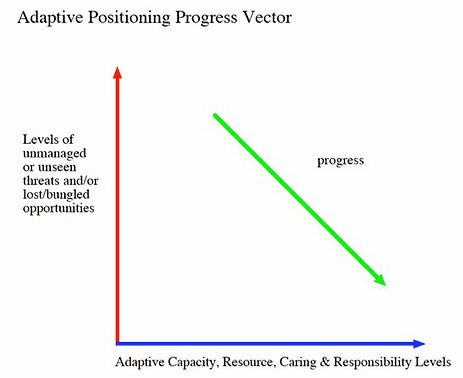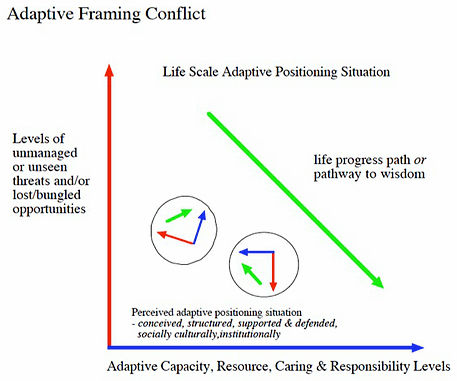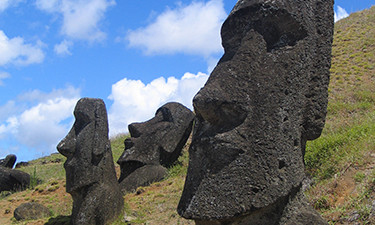Progress is difficult for most people to define. It’s relatively easy to come up with indicators of progress like increased education, health status or income, but how do you characterize the nature of progress?
We tend to think of progress as moving in an upward direction, where things just keep getting better. However, human progress is much more complicated than this. What seems like progress over the short term can end up being highly destructive over the longer term. Furthermore, anytime we create new capacities or resources, we also introduce new threats – so progress is not a simple forward movement.
To understand progress, you have to understand the dynamic relationship between capacities and challenges (Figure 1: Adaptive Positioning Progress Vector, below). Progress can be defined as any path of learning and action that moves in the direction of reducing threats/missed opportunities and increasing our capacity to deal with them. That relationship is critical, because we can reduce threats or maximize opportunities in ways that diminish our capacity. (Addictions are a classic example of this: drugs or alcohol might help you get through the day but, over time, substance abuse impedes your ability to meet life challenges and robs you of many opportunities). And we can create capacities that introduce new threats. (The development of the internet, for example, didn’t simply increase our power in positive ways; it introduced a whole range of new threats).
So progress looks like this:

Figure 1: Progress can be defined as any path of learning and action that moves in the direction of reducing threats/missed opportunities and increasing our capacity to deal with them.
The map above makes the construct of progress look relatively simple, but you have to remember that we are managing these capacity-challenge dynamics in multiple situations. So it’s more accurate to picture this as one of thousands of dials on a dashboard, where we’re trying to manage capacity-challenge dynamics across a myriad of situations. It gets even more complicated when you realize that the success metrics for one situation will often conflict with another. Now you understand why we get so confused about progress…
There’s an intelligent way to organize all of those capacity-challenge dynamics, however. The key is understanding that not all situations are equally significant. Challenges are nested and hierarchical, and every problem we solve is embedded within a larger set of problems and event flows. This means that wise or intelligent action requires an adaptive understanding of the largest situations in which we’re embedded. Without this understanding, whatever we’re doing in smaller frames of action can end up being terribly harmful and run counter to progress metrics in larger frames (as Figure 2: Adaptive Framing Conflict shows). Unfortunately, as humans we’re drawn to smaller frames of action because these situations demand our attention in a very immediate way. So we attend to challenges in narrow frames and do little to learn about those larger, more significant situations in which we’re all embedded.

Figure 2: In the smaller circles, the logic of the progress path still holds, but the metrics we are using in the smaller frame are very different than in the life scale. This is the central problem of society today. Our current understanding of progress and the metrics we use, help to convince ourselves what we do feels right and rational – but we are out of line with what life can sustain. Progress in the smaller frame is harmful to the larger frame or life system.
Most of the adaptive challenges facing humanity today stem from the fact that we don’t define progress within a life frame, and do little to understand the requirements of the largest situations in which we’re all embedded. Unless we reconstruct our understanding and application of progress, and widen and deepen our understanding of life, humanity will continue to be vulnerable. This reconstruction process is foundational to all intelligent action – and it comprises one of the key focuses for Human Venture Leadership Programs and Resources.



